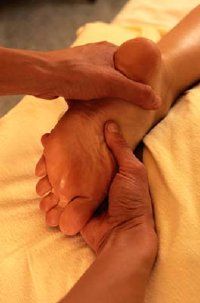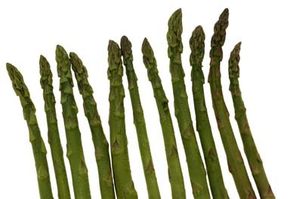Our poor, overworked feet. In a single day, they absorb about 1,000 pounds of force. And we mistreat them terribly -- standing on them for hours; walking on hard, unyielding surfaces; and cramming them into shoes that may be fashionable but are often far from comfortable. It's no wonder that four out of five adults eventually suffer from foot problems.
While certainly not as glamorous as the heart or the brain, the feet are amazing pieces of engineering, perfectly designed to give years of service -- if you treat them right. Each foot has 26 bones -- together the feet have almost one-quarter of the bones in the entire body. Thirty-three joints make the feet flexible, and 19 muscles control movement of foot parts. Tendons stretch tautly between muscles and bones, moving parts of the feet as the muscles contract. Two arches in the midfoot and forefoot, constructed like small bridges, support each foot and provide a springy, elastic structure to absorb shock. Numerous nerve endings in the feet make them sensitive (and ticklish). And the whole structure is held together by more than 100 ligaments.
Advertisement
Much of the foot pain we experience comes from overworked lower limbs. Movement of the foot is controlled by four groups of muscles in the leg. These muscles get a workout not only when our feet are visibly moving (such as when we walk or run) but even when we stand still, because they help keep us balanced and upright. And like nearly all muscles (the heart muscle is an exception), these muscles can become fatigued, decreasing their ability to properly support the feet and causing discomfort. Standing in place for long periods also tends to result in a pooling of blood in the lower extremities, which can cause uncomfortable swelling.
Here are some common problems that cause foot pain, most often due to an overuse injury.
Plantar fasciitis. A heel injury, affecting the area where the arch meets the heel. Plantar fasciitis is marked by heel pain with first steps in the morning, possible swelling, and heel pain while walking. It can usually be worked out with activity. What to do: Wear better shoes, or try orthopedic shoes prescribed by a podiatrist. Don't walk barefoot. Use ice unless you have circulatory problems or are diabetic. Try heel cups in your shoes for shock absorption. If the pain is persistent, see a podiatrist.
Heel spurs. A little outgrowth of the bone, a result of the bone's attempt to heal after repetitive stress and inflammation in the plantar fascia. What to do: If it causes foot pain, a simple surgery to shave the spur away may be required.
Neuroma. A pinched nerve, causing pain between the third and fourth toes. It can feel like a tooth that needs a root canal. One of the most common causes is a poor shoe fit. What to do: Buy a shoe with a wider toe area.
Tendonitis. An inflammatory process in the tendons, common in athletes. It can be a serious, painful, and persistent problem. What to do: Rest, ice, use anti-inflammatory drugs, and change exercise technique and shoe gear.
Stress fracture. A break in the bone usually resulting from repetitive pounding. Common to athletes. What to do: Limit weight bearing, and stick to low impact exercise. An orthotic device may be necessary to reduce pressure at the fracture site. Be sure to confirm and locate the stress fracture via X ray for proper treatment.
Ankle sprains. A ligament that is stretched or torn. It is the most common athletic injury. What to do: Ice, compression with an elastic bandage or splint to eliminate motion, and elevation to decrease swelling. Limit weight-bearing activities, and stay off feet for a few days. In cases of a severe sprain, your podiatrist may recommend a brace or surgery.
Here are a few more foot aches that aren't attributed to overuse. Instead, these are caused by simple everyday wear and tear, as well as poorly fit shoes.
Black toenail. A hematoma (bruising) under the nail. What to do: Wear proper-fitting shoes that aren't too tight or too loose, clip toenails short so they won't rub against the shoe, soak foot in salt water.
Bunions. A misaligned big toe joint in which the toe slants outward causing inflammation and swelling. The most common cause is tight-fitting shoes. What to do: Wear proper-fitting shoes and padding, and rest and soak the foot. Bunions must be treated by a podiatrist
Hammertoe. When a toe, usually the second toe, bends up to look like a claw. It frequently accompanies a bunion, and while the actual cause is a muscle imbalance, the underlying cause of that imbalance is usually an ill-fitting shoe that cramps the toes. What to do: Wear proper-fitting shoes and padding. Hammertoes must be treated by a podiatrist
Ingrown toenail. This happens when the side of your toenail cuts into your skin. The cause is usually a bad toenail clip job, but pressure from a bad shoe fit can cause it, too. A mild ingrown nail can be removed with careful clipping, but if it is deep or painful, consider a trip to the podiatrist.
Bad Shoes, Good Shoes
Bad shoes are what many foot injuries have in common. Bad shoes, according to the American College of Foot and Ankle Surgeons, are to blame for about 90 percent of all foot problems.
No matter what type of shoe you're wearing, a bad shoe is one that does not fit properly, has lost its shape, causes pain or rubbing, or is worn unevenly. Bad shoes cause foot and ankle problems. But they can cause leg and back problems, too.
To get a good fit for any type of shoe:
- Buy shoes at the end of the day, after work or exercise, when your feet are at their largest. If you buy shoes earlier in the day, they may be too tight.
- Measure both feet and fit your shoe to the largest one, since your feet aren't both the same size.
- Make sure you can wiggle your toes. If you can't, the fit is too tight. Also make sure the widest part of your foot is comfortable but secure.
- Walk around the store to see if the shoes are comfortable. Never buy shoes without first trying them on, and don't assume they will get comfortable with wear. If they don't feel good when you try them on, don't buy them.
- Try on shoes with the socks you plan to wear with them.
- When the shoe is on and you're standing up, make sure you can fit the width of your little finger between your heel and the back of the shoe -- no more and no less.
- If your heel slides in the shoe as you walk, the shoe doesn't fit.
- Don't let anyone tell you the shoe will stretch. Good shoes fit properly when you buy them.
- And, no matter how much you're attached to your closet full of comfortable old shoes, toss them in the trash when they are worn out and get new ones.
Now that you know what that foot pain might be, as well as possible treatment options, here are a few home remedies to help heal those tired, aching dogs. Visit these links to learn more about home remedies for foot ailments:
- To see all of our home remedies and the conditions they treat, go to our main Home Remedies page.
- Read Home Remedies for Back Pain to learn about home remedies that will help your aching back.
- If you're dealing with a serious case of foot funk, learn how to banish the odor in Home Remedies for Foot Odor.
- Learn how to stop the uncomfortable itching and burning of athlete's foot in Home Remedies for Athlete's Foot.
- Learn how to use natural home remedies to ease the discomfort of corns and calluses in Home Remedies for Calluses and Corns.
This information is solely for informational purposes. IT IS NOT INTENDED TO PROVIDE MEDICAL ADVICE. Neither the Editors of Consumer Guide (R), Publications International, Ltd., the author nor publisher take responsibility for any possible consequences from any treatment, procedure, exercise, dietary modification, action or application of medication which results from reading or following the information contained in this information. The publication of this information does not constitute the practice of medicine, and this information does not replace the advice of your physician or other health care provider. Before undertaking any course of treatment, the reader must seek the advice of their physician or other health care provider.
Advertisement


